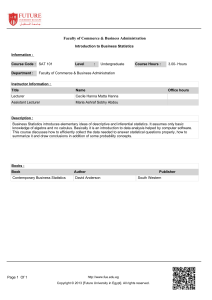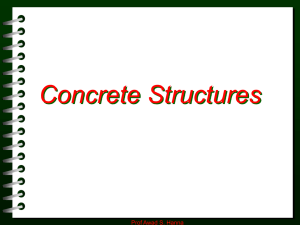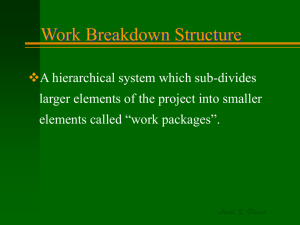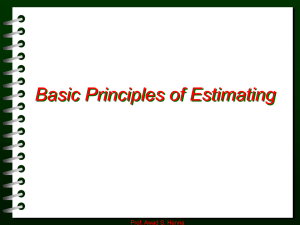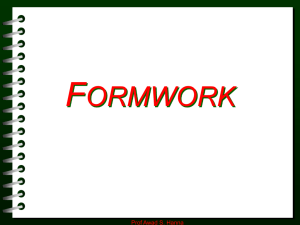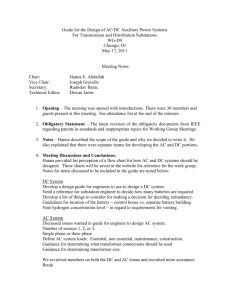Earthwork Estimation: Excavation, Grading & Volume Calculation
advertisement
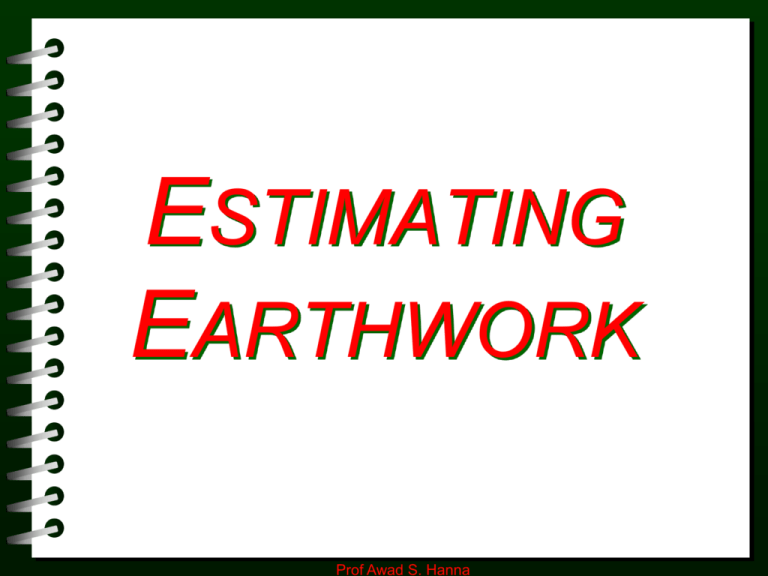
ESTIMATING EARTHWORK Prof Awad S. Hanna Estimating Earthwork Earthwork includes: 1. Excavation 2. Grading: Moving earth to change elevation 3. Temporary shoring 4. Back fill or fill: Adding earth to raise grade 5. Compaction: Increasing density 6. Disposal Prof Awad S. Hanna Productivity Factors A. Job conditions Material type Water level and moisture content Job size Length of haul Haul road condition (accessibility and load restrictions) Prof Awad S. Hanna Productivity Factors (cont.) B. Management conditions Equipment conditions and maintenance practices Skills of work force and management Planning, supervision and coordination of work. Prof Awad S. Hanna Job Efficiency Factors for Earthmoving Operations Management Condit ions* Job Condit ions** Excellent Good Fair Poor Excellent 0.84 0.81 0.76 0.70 Good 0.78 0.75 0.71 0.65 Fair 0.72 0.69 0.65 0.60 Poor 0.63 0.61 0.57 0.52 Prof Awad S. Hanna Units of Measure Cubic Yard (bank, loose, or compacted) Bank (BCY): Mat erials in it s nat ural st at e before dist urbance (in-place, in-sit u) Loose (LCY): Mat erial t hat has been compact ed or dist urbed or loaded Compact ed (CCY): Mat erial aft er compact ion Prof Awad S. Hanna 1.0 CUBIC YARD IN NATURAL CONDITION (IN-PLACE YARD) 1.25 CUBIC YARD AFTER DIGGING (LOOSE YARDS) 0.90 CUBIC YARD AFTER COMPACTED (COMPACTED YARDS) 1.25 1.0 In place 0.90 Loose Prof Awad S. Hanna Compacted Volume Bank: VB Bank cubic yards (BCY) Density B Lb /BCY Loose: Vl Loose cubic yards (LCY) Density L Lb/LCY Compacted: Vc Compacted cubic yards (CCY) Density C LB/CCY Prof Awad S. Hanna Swell: A soil increase in volume when it is excavated. Swell (%) = Bank density (Loose density Load factor = - 1) x 100 Loose density Bank density Bank Volume = Loose volume x Load factor Prof Awad S. Hanna Shrinkage: A soil decreases in volume when it is compacted Bank density Shrinkage (%) = (1 ) Compacted density x 100 Shrinkage factor = 1 - Shrinkage Compacted volume = Bank volume x Shrinkage factor Prof Awad S. Hanna Approximate Material Characteristics Mat erial Clay, dry Clay, wet Clay and gravel, dry Clay and gravel, wet Eart h, dry Eart h, moist Eart h, wet Gravel, wet Gravel, dry Sand, dry Sand, wet Sand and gravel, dry Sand and gravel, wet Loose (lb/cy) 2,100 2,700 2,400 2,600 2,215 2,410 2,750 2,780 3,090 2,600 3,100 2,900 3,400 Bank Swell Load (lb/cy) (%) Fact or 2,650 26 0.79 3,575 32 0.76 2,800 17 0.85 3,100 17 0.85 2,850 29 0.78 3,080 28 0.78 3,380 23 0.81 3,140 13 0.88 3,620 17 0.85 2,920 12 0.89 3,520 13 0.88 3,250 12 0.89 3,750 10 0.91 Exact values will vary with grain size, moisture content, compaction, etc. Test to determine exact values for specific soils. Prof Awad S. Hanna Typical Soil Volume Conversion Factors Init ial Soil Type Soil Condit ion Clay Bank Loose Compact ed Common eart h Bank Loose Compact ed Rock (blast ed) Bank Loose Compact ed Sand Bank Loose Compact ed Bank 1.00 0.79 1.11 1.00 0.80 1.11 1.00 0.67 0.77 1.00 0.89 1.05 Prof Awad S. Hanna Convrt ed t o: Loose Compact ed 1.27 0.90 1.00 0.71 1.41 1.00 1.25 0.90 1.00 0.72 1.39 1.00 1.50 1.30 1.00 0.87 1.15 1.00 1.12 0.95 1.00 0.85 1.18 1.00 Estimating Earth work for Trenches and Foundation 2’-0” or more Prof Awad S. Hanna Angle of Repose Approximate Angle of Repose Original Ground Line Solid Rock, Slate or Cemented Sand and Gravel (90 Deg.) For Sloping Sides of Excavation Prof Awad S. Hanna Calculating Earthwork Quantities 1.End Area Method 2.Contour Line/ Grid Method Prof Awad S. Hanna 1. End Area Method Used in sites where length is much greater than width Prof Awad S. Hanna CALCULATING EARTHWORK QUANTITIES 1. End Area Method a. Take cross-sections at regular intervals, typically, 100’ intervals. b. Calculate the cross-section end areas c. The volume of earthwork between sections is obtained by taking the average of the end areas at each station in square feet multiplied by the distance between sections in feet and dividing by 27 to obtain the volume in cubic yards. Prof Awad S. Hanna Project Site Showing 100 F’ 300' 86 84 82 80 E’ D’ 88 C’ B’ A’ Stations C B A 100' 100' E D 100' 500' Prof Awad S. Hanna 100' F 100' 80 Sec. A’- A 78.5 78 76 Project Cross Sections 82 Sec. B’- B 80.3 80 78 84 Sec. C’- C 82.3 82 80 86 Sec. D’- D 84.2 84 88 Sec. E’- E 86.2 86 90 Sec. F’- F 88.2 88 Prof Awad S. Hanna Cross-Section @ A - A Area = 107 x 1.0 2 80 = 53.5 79.5 79 78.5 78 76.7 Area = 193 x 1.8 2 77 = 173.7 Section A’- A Prof Awad S. Hanna 76 Cross-Section @ B - B Area = 90 x 1.5 2 82 = 67.5 81 80.3 80 76.7 Area = 210 x 1.8 2 79 = 189.0 Section B’- B Prof Awad S. Hanna 78 81.8 Table 1. Cumulative Earthwork Quantities Sect ion A-B B-C C-D D-E E-F Emb (CCY) Exc. (BCY) Exc. x B/C Net Exc. Cum Exc (CCY) (CCY) (CCY) 672 224 254 - 418 - 418 567 441 499 - 68 - 486 215 791 896 681 195 0 1031 1167 1167 1362 0 1222 1384 1384 2746 Prof Awad S. Hanna 2. Contour Line/ Grid Method Used for parking lots and site “leveling” Grid size from 10’x10’ to 50’x50’ the greater the terrain variance the smaller the grid Prof Awad S. Hanna 2. CONTOUR LINE/GRID CELL METHOD(cont.) Step l Determine by visual study of the site drawing if the net total will be an import (more fill required than cut) an export (less fill required than cut) or a blend (cut and fill about equal) Step 2 Determine the pattern of calculation points or grid size. Step 3 Determine elevations at each calculation location, the corners of each grid. Step 4 Calculate the cubic yards of cut or fill required in each grid cell. Step 5 Add the individual Grid Cell quantities together to arrive at the total cut, total fill volume and the import or volume export yardage required for the job. Prof Awad S. Hanna A C B E D F G 300’ 88’ 87.6 A 89’ 88.5 B 90’ 89.3 C 87.6 88.6 89.4 G H J 87.4 88.2 89.5 N O 87.2 87.7 No Scale P 89.0 91’ 90.3 92’ 93’ 94’ 91.5 E D 90.4 95.0 F 91.6 93.2 L M 90.6 91.6 92.7 Q R 90.4 91.3 K 93.5 S 92.0 Notes: 1. Bring the entire site to elevation 90. 2. All grids are 50’x 50’ = 2500 sq. ft. 3. Present contours Prof Awad S. Hanna 94.3 93.1 Purpose Grade the entire site to grade 90’ Need Fill Quick and Dirty Assume one grid Existing 90.50 Proposed 90.00 Cut 0.50 Need Cut 300' 90' 91' 90.5' Total Cost =150 x 300 x 0.50 = 833CY 27 Prof Awad S. Hanna 150' 90' If we choose the grid size to be 50’x50’ 88.6 Average elevation 87.6 = 87.6+88.5+87.6+88.6 4 = 88.08 change = 90-88.08 = 1.92 cut = = 177.77 CY and so on. 87.6 Prof Awad S. Hanna 87.6
